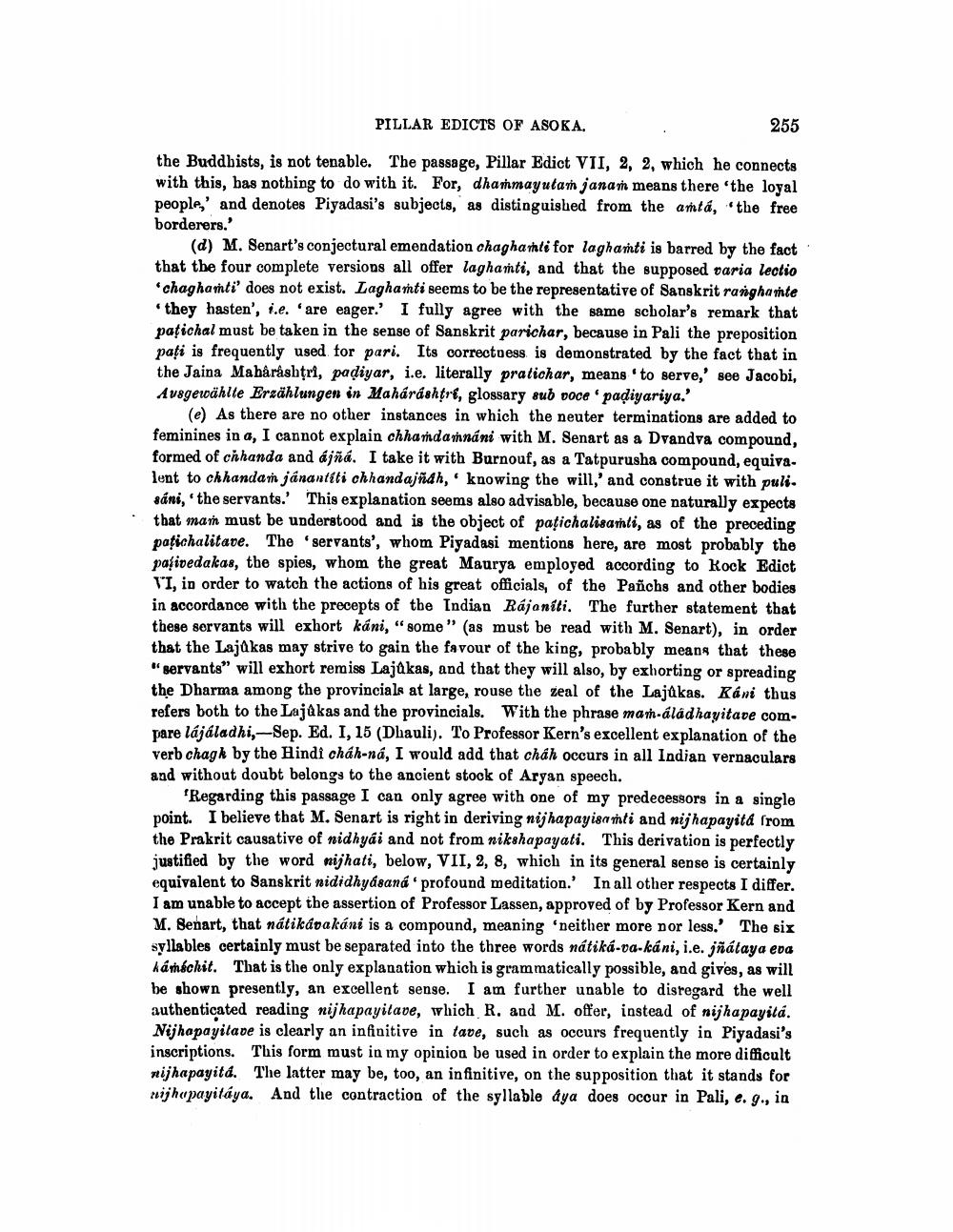________________
PILLAR EDICTS OF ASOKA.
255
the Buddhists, is not tenable. The passage, Pillar Edict VII, 2, 2, which he connects with this, bas nothing to do with it. For, dhammayutan janam means there 'the loyal people,' and denotes Piyadasi's subjects, as distinguished from the amta, the free borderers.'
(d) M. Senart's conjectural emendation chagharti for laghamti is barred by the fact that the four complete versions all offer laghamti, and that the supposed varia lectio 'chaghamti' does not exist. Lagharti seems to be the representative of Sanskrit ranghamte
they hasten', i.e. are eager.' I fully agree with the same scholar's remark that pațichal must be taken in the sense of Sanskrit parichar, because in Pali the preposition paţi is frequently used for pari. Its correctoess is demonstrated by the fact that in the Jaina Maharashtri, padiyar, i.e. literally pratichar, means to serve,' see Jacobi, Avsgewählte Erzählungen in Maharashtre, glossary sub voce 'padiyariya.'
(e) As there are no other instances in which the neuter terminations are added to feminines in a, I cannot explain chhandannáni with M. Senart as a Dvandva compound, formed of chhanda and ájñá. I take it with Burnouf, as a Tatpurusha compound, equivalent to chhandam janantiti chhandajňah, knowing the will,' and construe it with puli. sári, the servants. This explanation seems also advisable, because one naturally expects that man must be understood and is the object of pațichalisanti, as of the preceding patichalitave. The servants', whom Piyadasi mentions here, are most probably the pasidedakas, the spies, whom the great Maurya employed according to Rock Edict VI, in order to watch the actions of his great officials, of the Pañchs and other bodies in accordance with the precepts of the Indian Rájaniti. The further statement that these servants will exhort káni, "some" (as must be read with M. Senart), in order that the Lajakas may strive to gain the favour of the king, probably means that these "servants" will exhort remiss Lajakas, and that they will also, by exhorting or spreading the Dharma among the provincials at large, rouse the zeal of the Lajukas. Ráni thus refers both to the Lajukas and the provincials. With the phrase man-áladhayitade compare lájáladhi,-Sep. Ed. I, 15 (Dhauli). To Professor Kern's excellent explanation of the verb chagk by the Hindi chah-ná, I would add that chah occurs in all Indian vernaculars and without doubt belongs to the ancient stock of Aryan speech.
'Regarding this passage I can only agree with one of my predecessors in a single point. I believe that M. Senart is right in deriving nijhapayisamti and nijhapayitá from the Prakrit causative of nidhyái and not from nikshapayati. This derivation is perfectly justified by the word nijhati, below, VII, 2, 8, which in its general sense is certainly equivalent to Sanskrit nididhyasand profound meditation. In all other respects I differ. I am unable to accept the assertion of Professor Lassen, approved of by Professor Kern and M. Benart, that nátikádakáni is a compound, meaning 'neither more nor less.' The six syllables certainly must be separated into the three words nátiká-va-káni, i.e. jñátaya eda kámáchit. That is the only explanation which is grammatically possible, and gives, as will be shown presently, an excellent sense. I am further unable to disregard the well authenticated reading nijhapayitave, which R. and M. offer, instead of nijhapayita. Nijhapayitave is clearly an infinitive in tave, such as occurs frequently in Piyadasi's inscriptions. This form must in my opinion be used in order to explain the more difficult nijhapayitá. The latter may be, too, an infinitive, on the supposition that it stands for nijhapayitáya. And the contraction of the syllable dya does occur in Pali, e. 9., in




